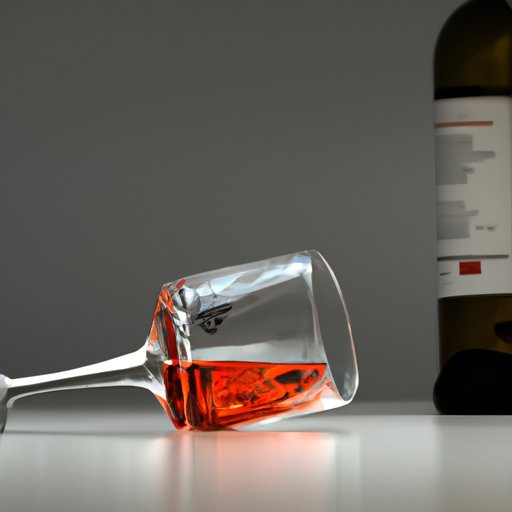Introduction
Alcohol has been a part of human civilization for centuries, with its consumption often playing a prominent role in many cultural traditions and social events. However, excessive alcohol intake can be dangerous and even deadly. Understanding how much it takes to get drunk can help people to drink responsibly and avoid the negative consequences of over-indulging in alcohol. In this article, we explore the science behind alcohol tolerance and examine how many shots it really takes to get drunk. We’ll also provide practical tips on responsible drinking and discuss the risks associated with heavy alcohol consumption.
Understanding the Science: Exploring the Factors Affecting Alcohol Intolerance
Alcohol tolerance varies greatly from person to person, and a variety of factors can influence how much alcohol an individual can handle before feeling its effects. Age, gender, weight, and genetics are all known to play a role in alcohol tolerance. Generally, younger people tend to have lower alcohol tolerance, and women tend to be more sensitive to alcohol than men due to differences in body composition. However, it’s important to note that even among people of the same age, gender, and weight, alcohol tolerance can vary significantly.
Metabolism, health conditions, and medication use can also impact alcohol tolerance. People with slower metabolisms may have a harder time breaking down alcohol, leading to a longer-lasting effect. Certain health conditions, such as liver disease, can make it more difficult for the body to metabolize alcohol, while medications like antibiotics or painkillers can enhance the effects of alcohol.
The Body’s Response to Alcohol: How Many Shots Does it Really Take to Get Drunk?
The term “drunk” refers to the state of intoxication caused by alcohol consumption. Blood alcohol concentration (BAC) is the measure used to determine an individual’s degree of intoxication. BAC is expressed as a percentage and indicates the amount of alcohol present in the bloodstream. The legal limit for driving in most states in the US is 0.08% BAC, but the effects of alcohol can be felt at much lower levels.
The rate at which alcohol is absorbed into the bloodstream varies depending on a variety of factors, such as the amount of food in the stomach. Generally, one drink is defined as a 12-ounce beer, a 5-ounce glass of wine, or a 1.5-ounce shot of hard liquor. How many drinks it takes to get drunk depends on an individual’s BAC tolerance level, which can vary depending on the factors discussed in the previous section.
At a BAC level of 0.02-0.03%, an individual may experience mild effects such as relaxation, increased sociability, and a slight sense of euphoria. At a BAC level of 0.05-0.06%, an individual may experience impaired judgment, lowered inhibitions, and a decrease in coordination. At a BAC level of 0.08% or higher, an individual may experience significant impairment of motor function, slurred speech, and even blackouts or loss of consciousness.
Too Much of a Good Thing: Risks and Dangers of Over-Indulging in Alcohol
Over-indulging in alcohol can lead to a number of risks and dangers, both in the short-term and long-term. Drinking too much can lead to alcohol poisoning, a serious and potentially life-threatening condition that occurs when the body’s BAC level reaches a dangerously high level. Alcohol poisoning can cause seizures, respiratory depression, and even coma or death.
Chronic heavy drinking can also lead to a number of long-term health problems, such as liver disease, pancreatitis, and an increased risk of cancer. Excessive drinking can also have negative social and economic impacts, including relationship problems, lost productivity at work, and increased healthcare costs.
The Art of Moderation: Tips and Tricks for Drinking Responsibly
Drinking alcohol can be a fun and enjoyable experience, but it’s important to do so responsibly. One of the best ways to do this is by pacing yourself and alternating drinks with water. Drinking on a full stomach can also help to slow the absorption of alcohol into the bloodstream. It’s also important to avoid peer pressure and know your limits.
Drinking in moderation has been shown to have a number of social, cultural, and personal benefits. Moderate drinking has been linked to reduced risk of heart disease and improved cognitive function, and it can also be a way to relax and unwind with friends or family.
Setting Limits: How to Determine Your Personal Tolerance for Alcohol
Knowing your personal alcohol tolerance is key to drinking responsibly. A variety of tools and resources are available to help individuals measure their BAC levels. Breathalyzers are widely available and can be purchased for personal use. Signs of intoxication, such as slurred speech, impaired coordination, and impaired judgment, should also be recognized and respected.
It’s also important to respect the limits of others. Drinking should never be forced or coerced, and it’s important to recognize when someone has had too much to drink and needs assistance. Professional help is available for individuals struggling with alcohol abuse or addiction.
Making Safe Choices: Importance of Knowing How Many Shots it Takes to Get Drunk
Drinking responsibly means knowing how much alcohol your body can handle and making informed decisions about alcohol consumption. By understanding the science behind alcohol tolerance and being aware of the risks associated with heavy drinking, individuals can make safe and informed decisions about their alcohol consumption.
Ultimately, responsible drinking means finding the right balance between enjoyment and safety. By following the tips and advice outlined in this article, individuals can enjoy alcohol in a way that is both smart and safe.
Conclusion
Understanding alcohol tolerance and knowing how many shots it takes to get drunk is key to drinking responsibly. By knowing your personal tolerance level and recognizing the risks associated with heavy drinking, you can enjoy alcohol in a way that is both fun and safe. Remember to pace yourself, alternate drinks with water, and respect the limits of others.
